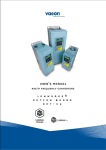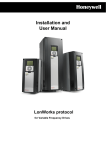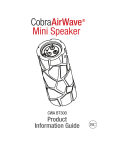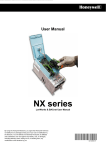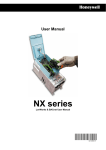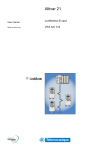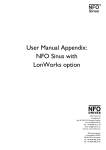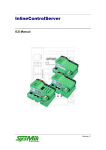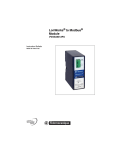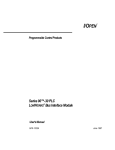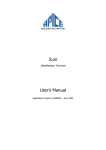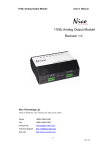Download Siemens BT300 Lonworks Option Board
Transcript
Revision B Siemens BT300 Lonworks Option Board Installation and User's Manual www.sbt.siemens.com Siemens Industry Inc. • 1 table of contents Document: DPD01157B Rev B Version release date: March 6, 2013 1. Safety ..................................................................................................................3 1.1 1.2 1.3 Danger .......................................................................................................................................... 3 Warnings....................................................................................................................................... 4 Earthing and earth fault protection................................................................................................ 5 2. Installation, layout and connections................................................................7 2.1 2.2 2.3 Installation..................................................................................................................................... 7 Prepare for use through LonWorks............................................................................................... 9 Layout ......................................................................................................................................... 12 2.3.1 BT300 OPT-C4 option board......................................................................................... 12 Connections................................................................................................................................ 13 2.4.1 LED indications.............................................................................................................. 13 2.4 3. 4. LonWorks - General information....................................................................15 LonWorks technical data ................................................................................17 4.1 4.2 4.3 4.4 Quick Setup ................................................................................................................................ 17 Technical data ............................................................................................................................ 17 Physical media and wiring .......................................................................................................... 18 Profiles........................................................................................................................................ 19 4.4.1 Variable speed profile.................................................................................................... 19 5. Commissioning................................................................................................21 5.1 5.2 I/O and Hardware menu (M5) ..................................................................................................... 21 LonWorks board parameters ...................................................................................................... 21 6. LonWorks interface .........................................................................................23 6.1 6.2 6.3 6.4 6.5 XIF file......................................................................................................................................... 23 General ....................................................................................................................................... 23 Input Network Variables.............................................................................................................. 25 Output network variables ............................................................................................................ 27 Network configuration variables.................................................................................................. 29 7. Fault tracing .....................................................................................................31 7.1 Typical fault conditions ............................................................................................................... 31 24-hour support +1-800-877-7545 (Dial 2) Siemens Industry, Inc. • 2 24-hour support +1 -800-877-7545 (Dial 2) Safety 1. Siemens Industry, Inc. • 3 Safety This manual contains clearly marked cautions and warnings which are intended for your personal safety and to avoid any unintentional damage to the product or connected appliances. Please read the information included in cautions and warnings carefully. The cautions and warnings are marked as follows: Table 1. Warning signs. = DANGER! Dangerous voltage = WARNING or CAUTION = Caution! Hot surface 1.1 Danger The components of the power unit of the Siemens BT300 drive are live when the drive is connected to the primary input voltage. Coming into contact with this voltage is extremely dangerous and may cause death or severe injury. The motor terminals U, V, W and the brake resistor terminals are live when the drive is connected to mains, even if the motor is not running. After disconnecting the drive from the mains, wait until the indicators on the keypad go out (if no keypad is attached see the indicators on the cover). Wait 5 more minutes before doing any work on the connections of the Siemens BT300 drive. Do not open the cover before this time has expired. After expiration of this time, use a measuring equipment to absolutely ensure that no voltage is present. Always ensure absence of voltage before starting any electrical work! The control I/O-terminals are isolated from the primary input voltage. However, the relay outputs and other I/O-terminals may have a dangerous control voltage present even when the Siemens BT300 drive disconnected from mains. Before connecting the drive to mains make sure that the front and cable covers of Siemens BT300 drive are closed. During a ramp stop (see the Application Manual), the motor is still generating voltage to the drive. Therefore, do not touch the components of the drive before the motor has completely stopped. Wait until the indicators on the keypad go out (if no keypad is attached see the indicators on the cover). Wait an additional 5 minutes before starting any work on the drive. 24-hour support +800 877-7545 (Dial 2) Siemens Industry, Inc • 4 1.2 Safety Warnings The Siemens BT300 drive is meant for fixed installations only. Do not perform any measurements when the drive is connected to the mains. The earth leakage current of Siemens BT300 drives exceeds 3.5mA AC. According to standard EN61800-5-1, a reinforced protective ground connection must be ensured. See chapter 1.3. If the drive is used as a part of a machine, the machine manufacturer is responsible for providing the machine with a supply disconnecting device (EN 60204-1). Only spare parts delivered by Siemens can be used. At power-up, power brake or fault reset the motor will start immediately if the start signal is active, unless the pulse control for Start/Stop logic has been selected. Furthermore, the I/O functionalities (including start inputs) may change if parameters, applications or software are changed. Disconnect, therefore, the motor if an unexpected start can cause danger. The motor starts automatically after an automatic fault reset if the auto restart function is activated. See the Application Manual for more detailed information. Prior to measurements on the motor or the motor cable, disconnect the motor cable from the drive. Do not touch the components on the circuit boards. Static voltage discharge may damage the components. Check that the EMC level of the drive corresponds to the requirements of your supply network. 24-hour support +800 877-7545 (Dial 2) Safety 1.3 Siemens Industry, Inc. • 5 Earthing and earth fault protection CAUTION! The Siemens BT300 drive must always be earthed with an earthing conductor connected to the earthing terminal marked with . The earth leakage current of Siemens BT300 exceeds 3.5mA AC. According to EN61800-5-1, one or more of the following conditions for the associated protective circuit shall be satisfied: a) The protective conductor shall have a cross-sectional area of at least 10 mm2 (8 AWG) Cu or 16 mm2 (6 AMG) Al, through its total run. b) Where the protective conductor has a cross-sectional area of less than 10 mm2 Cu or 16 mm2 (6 AWG) Al, a second protective conductor of at least the same cross-sectional area shall be provided up to a point where the protective conductor has a cross-sectional area not less than 10 mm2 (6 AWG) Cu or 16 mm2 (Al. c) Automatic disconnection of the supply in case of loss of continuity of the protective conductor. The cross-sectional area of every protective earthing conductor which does not form part of the supply cable or cable enclosure shall, in any case, be not less than: - 2.5 mm2 (14 AWG) if mechanical protection is provided or - 4 mm2 (12 AWG) if mechanical protection is not provided. The earth fault protection inside the drive protects only the drive itself against earth faults in the motor or the motor cable. It is not intended for personal safety. Due to the high capacitive currents present in the drive, fault current protective switches may not function properly. Do not perform any voltage withstand tests on any part of the Siemens BT300 drive. There is a procedure according to which the tests should be performed. Ignoring this procedure may result in a damaged product. 24-hour support +800 877-7545 (Dial 2) Siemens Industry, Inc • 6 Safety 24-hour support +800 877-7545 (Dial 2) Installation, layout and connections Siemens Industry, Inc. • 7 2. Installation, layout and connections 2.1 Installation Open the cover of the variable frequency drive. 1 The relay outputs and other I/O-terminals may have a dangerous control voltage present even when the Siemens BT300 drive is disconnected from mains. DANGER 24-hour support +1 800-877-7545 (Dial 2) Siemens Industry, Inc. • 8 Installation, layout and connections Make sure that the sticker on the connector of the board says “dv” (dual voltage). This indicates that the board is compatible with the Siemens BT300 drive. See below: 2 21 22 23 Slot coding NOTE: Incompatible boards cannot be installed on the Siemens BT300 drive. Compatible boards have a slot coding that enable the placing of the board (see above) Open the inner cover (1) to reveal the option board slots (D,E) and install the fieldbus board (2) into slot D or E. D is recommended because it puts the Lonworks communication wire farther from the drive output. Close the inner cover. See Figure below. 1 2 D E 3 24-hour support +1 800-877-7545 (Dial 2) Installation, layout and connections 2.2 Siemens Industry, Inc. • 9 Prepare for use through LonWorks Strip about 15 mm of the fieldbus cable (see specification on page 18) and cut off the grey cable shield. Remember to do this for both bus cables (except for the last device). Leave no more than 10 mm of the cable outside the terminal block and strip the cables at about 5 mm to fit in the terminals. See picture below. 10 (.4) 5 (.2) BT9189 mm (in.) 4 Also strip the cable now at such a distance from the terminal that you can fix it to the frame with the grounding clamp. Strip the cable at a maximum length of 15 mm. Do not strip the aluminum cable shield! 15 in) (.6 m m 9188.emf Then connect the cable to its appropriate terminals on LonWorks Option Board terminal block. 21 22 23 5 Data 1 Data 2 Fieldbus cable 24-hour support +1 800-877-7545 (Dial 2) Shield Siemens Industry, Inc. • 10 Installation, layout and connections Using the cable clamp included in the delivery of the drive, ground the shield of the LonWorks cable to the frame of the drive. Cable clamp 6 If the Siemens BT300 drive is the last device on the bus, the bus termination must be set. To assure a proper data transmission, termination of the network segments is required. Depending on the type of network, either one or two terminations are necessary. Free topology network segment requires only one termination whereas a doubly terminated bus topology requires two. The jumper X5 on the Siemens BT300 LonWorks board must be set accordingly. • Use 94 - 105 ohms for bus termination resistance at both ends of the segment. • 47-ohm termination resistance if using free topology if the drive is in the middle of the network. NOTE: In free topology, only one device is terminated. See also step 10 on Page 11. 7 H3 H2 H1 47 X5 94 no termination X5 21 22 23 24-hour support +1 800-877-7545 (Dial 2) Installation, layout and connections Siemens Industry, Inc. • 11 Unless already done for the other control cables, cut free the opening on the drive cover for the fieldbus cable (protection class Type 1/IP21). NOTE: Cut the opening on the same side you have installed the board in! 8 Remount the drive cover and run the cable as shown in picture. NOTE: When planning the cable runs, remember to keep the distance between the fieldbus cable and the motor cable at a minimum of 30 cm (11.8 in.). 9 Fieldbus cable The bus termination must be set for the first and the last device of the fieldbus line. See picture below. See also step 7 on page 13. We recommend that the first device on the bus and, thus, terminated was the Master device. 10 24-hour support +1 800-877-7545 (Dial 2) Siemens Industry, Inc. • 12 2.3 Installation, layout and connections Layout The Siemens LonWorks Fieldbus Board is connected to the fieldbus through 3-pin pluggable bus connector. The communication with the control board takes place through the standard Siemens Interface Board Connector. 2.3.1 BT300 OPT-C4 option board H3 H2 H1 21 22 23 X5 Figure 1. 24-hour support +1 800-877-7545 (Dial 2) Installation, layout and connections 2.4 Siemens Industry, Inc. • 13 Connections Table 2. Connections Signal Connector Description DATA 1 21 Fieldbus connection DATA 2 22 Fieldbus connection Shield 23 Fieldbus connection 2.4.1 LED indications The three LED indications (see Figure 1) next to the connector show the present statuses of the Neuron (green H3), the LonWorks board (yellow H2) and the Fieldbus Module (green H1). From the user's viewpoint, the first two are the most significant. Neuron status (H3) GREEN LED is OFF ON Flashing Description State code Configured Applicationless and Unconfigured Unconfigured 4 3 2 Board status LED (H2) YELLOW LED is Description OFF Option board not activated. Option board in initialization state waiting for activation command from ON the variable frequency drive. Blinking fast (once/ Option board is activated and in RUN state. 1 s) Option board is ready for external communication. Blinking slow Option board is activated and in FAULT state. (once/5 s) Internal fault on option board. Bus status LED (H1) GREEN LED is OFF ON Description Fieldbus module is waiting for parameters from the variable frequency drive. No external communication. Fieldbus module is activated. Parameters received and module activated. Module is waiting for messages from the bus. Blinking very fast Fieldbus module has received a wink request. for 5s (once/0.2 s) Blinking fast (once/ Module is activated and receiving messages from the bus. 1 s) Module is in FAULT state. Blinking slow (once/ No messages from Net within the watchdog time. 5 s) Bus broken, cable loose. 24-hour support +1 800-877-7545 (Dial 2) Siemens Industry, Inc. • 14 Installation, layout and connections 24-hour support +1 800-877-7545 (Dial 2) LonWorks - General information 3. Siemens Industry, Inc. • 15 LonWorks - General information The Siemens BT300 variable frequency drives can be connected to the LonWorks® network using a fieldbus board. The converter can then be controlled, monitored and programmed from the Host system. LONWORKS technology has been developed by Echelon Corporation. LONWORKS network is used in applications like industry and building automation, controlling household electronics, medical instrumentation and many others. The target of the LONWORKS network is to provide a common vendor independent communication network for intelligent devices. In a LONWORKS network, no central control or master-slave architecture is needed. Nodes on a network communicate with each other using LonTalk® protocol. Inter-operable nodes use Standard Network Variable Types (SNVT) for communicating over the network. The definition of an SNVT includes units, a range, and an increment. The Siemens option board uses only Standard Network Variable Types for the data types. All network variables are either input (data is coming from the network to the device) or output (data is sent to the network by the device) network variables. When network variables on different nodes on the network have been bound together by an installation tool, passing of data is automatic between the right nodes. Only the same type of network variables can be bound together, so it is very important to have compatible interfaces. 24-hour support +1 800-877-7545 (Dial 2) Siemens Industry, Inc. • 16 LonWorks - General information 24-hour support +1 800-877-7545 (Dial 2) LonWorks technical data 4. LonWorks technical data 4.1 Quick Setup Siemens Industry, Inc. • 17 Variable frequency drive application. Choose Fieldbus (Bus/Comm) for the active control place (see Chapter “I/O and Hardware menu (M5)” on page 21). Using a Lonworks tool to setup the drive. 1. Write 100.0 1 to nviDrvSpeedStpt. 2. The status of the variable frequency drive is RUN and the output frequency is 1.00 * nviDrvSpeedScale 3. Write 0.0 0 to nviDrvSpeedStpt 4. The status of the variable frequency drive is STOP. If nvoDrvStats bit 3 = 1, the status of the variable frequency drive is FAULT. NOTE: Commissioning of the Lon option requires a third party tool such as NLUtil or LonMaker. To transmit a service pin for identification on a LonWorks network, complete the following changes: NOTE: The Lon Option card can be installed in slot D or Slot E. The menu structure used below assumes that slot D was used. Navigate: Main Menu > I/O and Hardware (M5) > OPTC4 (M5.2) > Parameters (M5.2.3 > Service Pin (M5.2.3.1) > Edit > Set to a value of 1. Then complete the NLUtil or LonMaker commissioning. For commanding of Run/Stop via LonWorks complete the following (in addition to the Monitoring steps above): Navigate: Main Menu > Quick Setup (M1) > Ctrl. Place Auto (M1.15) > Edit > Select FieldBusCTRL For commanding of Speed Reference via LonWorks complete the following (in addition to the monitoring steps above): Navigate: Main Menu > Quick Setup (M1) > I/O A Ctrl Ref (M1.10) > Edit > Select Fieldbus 4.2 Technical data Connections and communications Environment Safety Table 3. Lonworks technical data. Interface Pluggable connector (5 mm) Channel type TP/FT-10 Communication cable Shielded Twisted Pair Baud rate 78 Kbit/s Ambient operating tem-10°C…50°C perature Storing temperature -40°C…70°C Humidity <95%, no condensation allowed Altitude Max. 1000 m Vibration 0.5 G at 9…200 Hz Fulfills EN50178 standard 24-hour support +1 800-877-7545 (Dial 2) Siemens Industry, Inc. • 18 4.3 LonWorks technical data Physical media and wiring LONWORKS networks can be implemented on many different physical media. The Siemens OPT-C4 option board is equipped with an FT-X1 transceiver supporting the Free Topology transformer coupled network, which allows the network wire to be connected as bus, star, loop or combination thereof. This media reaches a communication speed of 78kBits/s. The FT-X1 transceiver is compatible with Echelon's LPT-10 Link Power Transceiver, and these transceivers can communicate with each other on a single twisted pair cable. Termination Termination Figure 2. Doubly terminated bus topology Use the doubly terminated bus topology. However, also singly terminated, star or loop topologies can be used with the OPT-C4 option board. Up to 64 FTT-10 transceiver nodes are allowed per network segment. The individual segments can be connected together by a router. See Table 3 for possible cable types and cable lengths for the FTT-10. Even if unshielded cable types can be used with this type of transceiver, it is still highly recommended to use only shielded cables with variable frequency drives. Attention should be paid to proper grounding of the shield to ensure bus operation. Grounding of the shield should be done at both ends of the cable. Table 4. LonWorks FLN Trunk Wire Types and Maximum Length. Maximum length per Wire type LonWorks FLN segment No. 22 AWG Level 4 per NEMA standards 500 m (1,640 feet) Table 5. Network Wire Length vs. Gauge. Free Topology Bus Total Wire Distance Max. Node to Node Distance Total Wire Distance Max node to Node Distance 500 m (1,640 ft) 500 m (1,640 ft) 2,700 m (8,858 ft) Max. Stub Length 3 m (10 ft) 2,700 m (8,858 ft) 500 m (1,640 ft) 400 m (1,312 ft) 2,700 m (8,858 ft) Max. Stub Length 3 m (10 ft) 2,700 m (8,858 ft) 22 AWG (0.34 mm) Level 43 500 m (1,640 ft) 400 m (1,312 ft) 1,400 m (4,593 ft) Max. Stub Length 3 m (10 ft) 1,400 m (4,593 ft) CAT 5 TP / TIA 568A Category 5 cable/24AWG (0.5mm) 450 m (1,476 ft) 250 m (820 ft) 900 m (2,953 ft) 900 m (2,953 ft) Wire Gauge 16 AWG (1.5 mm) TPControl/Signaling Grade1 16 AWG (1.5 mm) TPGeneral Purpose Grade2 1. Control/Signaling Grade /16 AWG = Single twisted pair, stranded 19/29, unshielded, Teflon insulation and jacket High Temperature 150°C Max. 2. General purpose-grade /16 AWG = single twisted pair, stranded 19/29 unshielded, PVC Insulation andjacket Medium temperature 80°C Max. 3. Level IV cable per NEMA standards (Not equivalent to EIA/TIA Level 4 cable) 24-hour support +1 800-877-7545 (Dial 2) LonWorks technical data 4.4 Siemens Industry, Inc. • 19 Profiles LonMark Functional Profiles describe in detail the application layer interface, including the network variables, configuration properties, and default and power-up behaviors required on LonMark devices for specific, commonly used control functions. 4.4.1 Variable speed profile Leading manufacturers of drive technology have jointly defined the LonMark profile. The profile specifies how to parameterize the drives and how to transmit setpoints and actual values. This allows drives from different vendors to be replaced. The profile contains specifications for speed control and positioning. It specifies the basic drive functions while leaving sufficient freedom for application-specific expansions and further development. 24-hour support +1 800-877-7545 (Dial 2) Siemens Industry, Inc. • 20 LonWorks technical data 24-hour support +1 800-877-7545 (Dial 2) Commissioning 5. Siemens Industry Inc. • 21 COMMISSIONING Please read first the commissioning chapter in the Siemens BT300 HVAC Installation manual (DPDP1148B). 5.1 I/O and Hardware menu (M5) The I/O and Hardware menu makes it possible for the user to • • • see what expander boards are connected to the control board. reach and edit the parameters associated with the expander board. retrieve Software information. 5.2 Code M5.x.3.1 LonWorks board parameters Parameter Service Pin Min 0 24-hour support +1 800-877-7545 (Dial 2) Max 1 Unit Default 0 ID Description Setting this parameter to a value of 1 broadcasts a service pin message to the network. Siemens Industry, Inc. • 22 Commissioning 24-hour support +1 800-877-7545 (Dial 2) LonWorks interface 6. Siemens Industry, Inc. • 23 LONWORKS INTERFACE Features of the LonWorks interface: • Direct control of the Siemens BT300 drive (e.g. Run, Stop, Direction, Speed reference, Fault reset) • Full access to all the Siemens BT300 drive parameters • Monitor the Siemens BT300 drive’s status (e.g. Output frequency, Output current, Fault code) 6.1 XIF file XIF file tells network-management tools how to communicate and recognize a device. It contains Program ID, NVs, CPs, functional blocks, etc. 6.2 General Node Object:0 nviRequest nv1 SNVT_obj_request Mandatory Network Variables nv2 nv oStatus SNVT_obj_s tatus Figure 3. The node object diagram. 24-hour support +1 800-877-7545 (Dial 2) Siemens Industry, Inc. • 24 LonWorks interface Variable Speed Motor drive: 6010 nv1 nv iDrvSpeedStpt SNVT_obj_request nv2 nviDrvSpeedScale SNVT_levPercent Mandatory Network Variables Optional Network Variables nvoDrvSpeed SNVT_levPercent nv4 nv1 nviRequest SNVT_obj_request nv1 nviRequest SNVT_obj_request nv1 nviRequest SNVT_obj_request Configuration properties nc50 nciMaxSpeed nc53 nciMinSpeed nc48 nciRcvHrtBt nc49 nciSndHrtBt nc52 nciMinOutTm nc158 nciNmlSpeed nc158 nciNmlFreq nc160 nciRampUpTm nc161 nciRampDownTm nc162 nciDrvSpeedScale Manufacturer Defined Network Variables nv8 nviRstFault SNVT_swit ch nv9 nviCrlCntr SNVT_swit ch nv10 nviProc essIN1 SNVT_lev_percent nv11 nviProcessIN2 SNVT_lev_percent nv30 nv oProcessO ut1 SNVT_lev_percent nv12 nviProcessIN3 SNVT_lev_percent nv31 nv oProcessOut2 SNVT_lev_percent nv13 nviProcessIN4 SNVT_lev_percent nv32 nvoProces sOut 3 SNVT_lev_percent nv14 nviProcessI N5 SNVT_lev_perc ent nv33 nvoProcessOut4 SNVT_lev_percent nv15 nv iProcessIN6 SNVT_lev_percent nv34 nvoProces sOut 5 SNVT_lev_percent nv16 nviProcessIN7 SNVT_lev_percent nv35 nvoProces sOut 6 SNVT_lev_percent nv17 nviProcessIN8 SNVT_lev_percent nv36 nvoProcessOut7 SNVT_lev_perc ent nv37 nvoProcessOut8 SNVT_lev_perc ent nv27 nvoDrvSt atus SNVT_state nv28 nvoDrvStatus SNVT_stat e nv29 nvoActFault SNVT_count nv18 nviDigitalIn1 SNVT_switch nv19 nviDigitalIn2 SNVT_switch nv38 nvoDigitalOut1 SNVT_swit ch nv20 nviDigitalI n3 SNVT_swit ch nv39 nvoDigitalOut2 SNVT_swit ch nv21 nviDigitalIn4 SNVT_switch nv40 nvoDigitalOut3 SNVT_switch nv22 nviDigitalIn5 SNVT_switch nv41 nv oDigitalOut 4 SNVT_switch nv23 nviDigitalIn6 SNVT_switch nv42 nvoDigitalOut5 SNVT_switch nv24 nv iDigitalIn7 SNVT_switch nv43 nv oDigitalOut 6 SNVT_switch nv25 nviDigitalIn8 SNVT_switch nv44 nvoDigitalOut7 SNVT_switch nv45 nviParCmd SNVT_reset nvoDigitalOut8 SNVT_switch nv26 nv46 nvoParResp SNVT_preset Figure 4. The Variable Speed Motor Drive object diagram 24-hour support +1 800-877-7545 (Dial 2) LonWorks interface 6.3 Siemens Industry, Inc. • 25 Input Network Variables Table 6. Input network variables. Function Variable Name SNVT Type Node Object request nviRequest SNVT_obj_request Driver speed setpoint nviDrvSpeedStpt SNVT_switch Driver set point speed scaling nviDrvSpeedScale SNVT_lev_percent Min. value Max. value n/a n/a -163.840% 163.830% Reset fault nviRstFault SNVT_switch n/a n/a Clear kWh trip or Drive total running hours trip counters nviClrCntr SNVT_switch 1 2 Process In Data nviProcessIn1..8 SNVT_lev_percent 0 65535 Digital Inputs nviDigitalIn1..8 SNVT_switch 0 4 nviParCmd SNVT_preset n/a n/a Parameter Set nviRequest This input network variable provides the mechanism to request a particular mode for the Node object or the Variable Speed Motor Drive object within a node. Supported requests are RQ_NORMAL, RQ_UPDATE_STATUS, RQ_CLEAR_STATUS, RQ_REPORT_MASK, RQ_DISABLED, RQ_ENABLE and RQ_CLEAR_ALARM. nviDrvSpeedStpt This input network variable provides control and a low resolution speed setpoint. Table 7. State Value Command 0 NA Stop 1 0 0% 1 1 to 200 0.5 to 100% 1 201 to 255 100.0% 0xFF NA Auto nviDrvSpeedScale This input netork variable provides scaling for nviDrvSpeedStpt. Negative values indicate a motor direction in reverse. For example, if the nviDrvSpeedStpt value is 50% and nviDrvSpeedScale -150%, then the actual speed setpoint is -75%, or 0.75 times the nominal speed in reverse direction. The valid range is -163,840% to 163,830. The value 0x7FFF (+163,835%) will be handled as an invalid value. Default value is determined by nciDrvSpeedScale. This value will be adopted at power-up and in case of not receiving an update within the specified Receive Heartbeat time. nviRstFault This input network variable provides a fault reset. Setting value 1 for State and a non-zero value for Value will reset an active fault in the Siemens BT300 drive. Default value is 0; 0 Table 8. Fault table. State Value Command 0 any no action (0; 0) 1 0 no action (0; 1) 1 >0 reset fault (200 ; 0) -1(0xFF) any invalid (no action) 24-hour support +1 800-877-7545 (Dial 2) Siemens Industry, Inc. • 26 LonWorks interface nviClrCntr This input network variable provides a mechanism to clear the kWh trip counter or the drive total running hours trip counter. 1 = MWh trip counter 2 = Operation day trip counter nviProcessInl..8 These input network variables are sent directly to the application (see more detailed explanation in chapter 6.5 Process data) The valid range is 0 to 65535 (-163,840 to 163,835). nviDigitalIn1 ..8 These input network variables are sent directly to the application (see more detailed explanation in chapter 6.5 Process data) Default value is 0; 0. Table 9. State Value Command 0 any off (0; 0) 1 0 off (0; 1) 1 >0 on (200 ; 0) -1(0xFF) any invalid (no action) nviParCmd This input network variable is used to read and write the parameters. Parameter addresses are determined in the application. Every parameter and actual value has been given an ID number in the application. The ID numbering of the parameter as well as the parameter ranges and steps can be found in the application manual. The parameter value must be given without decimals. Find the ID numbers of each parameter/actual value in the application manual. The ID numbers are grouped as follows: Table 10. Parameter ID Group 0 Not used 1 … 98 Actual Values 37 Active Fault Code 100 Not used 101… 899 Parameter 900 … 999 Reserved 1000 Not used 1001…1999 Parameter Description Reserved for LonWorks board internal usage Examples Data format in examples is: - learn selector <byte(3) byte(2) byte(1) byte(0)> day hour minute second millisecond x = meaningless Example1 Write to parameter number 102 (Max frequency "HVAC Application par. ID102") value 4500 (45Hz). Write command to nviParSet - LN_LEARN_CURRENT 102 <x x 11 94> x x x x 24-hour support +1 800-877-7545 (Dial 2) LonWorks interface Siemens Industry, Inc. • 27 If the write command is successful then nvoParOut value is - LN_LEARN_CURRENT 102 <0 0 11 94> 0 0 0 0 If the write command fails then nvoParOut value is - LN_NUL 102 <0 0 11 94> 0 0 0 0 Example2 Read parameter number 112 (Nominal speed of the motor "HVAC Application par. ID112") default value 1440 (1440 rpm). Read command to nviParSet - LN_RECALL 112 <x x x x> x x x x If the read command is successful then nvoParOut value is - LN_RECALL 112 <0 0 5 A0> 0 0 0 0 If the read command fails then nvoParOut value is - LN_ LN_NUL 112 <0 0 0 0> 0 0 0 0 6.4 Output network variables Table 11. Output network variables Function Variable Name Node Object status SNVT Type Min. Value Max. Value nvoStatus SNVT_obj_status Drive speed feedback nvoDrvSpeed SNVT_lev_percent -163.840% +163.830% Actual motor current nvoDrvCurnt SNVT_amp 0.0A 3276.7A nvoDrvPwr SNVT_power_kilo 0,0 kW 6553,5 kW SNVT_time_hour 0h 65535 Actual drive power Drive total running hours nvoDrvRunHours Status word nvoDrvStatus SNVT_state n/a n/az kWh trip counter nvoDrvEnrgy SNVT_elect_kwh 0kWh 65535kWh Active fault code nvoActFault SNVT_count 0 41 nvoProcessOut1..8 SNVT_ lev_percent 0 65535 nvoDigitalOut1..8 SNVT_switch 0 4 nvoParResp SNVT_preset Process Out Digital Out Parameter Out nvoStatus This output network variable reports the status for Node object or Variable Speed Motor Drive object Table 12. Field Description object_id ID of object within node invalid_id 1 means requested ID is not implemented in this node invalid_request 1 means request for unimplemented function disabled 1 means object disabled electrical_fault 1 means drive is faulted in_alarm 1 means drive is in alarm report_mask 1 means status is an event mask nvoDrvSpeed This output network variable provides the speed of the drive as a percentage of the nominal speed. 24-hour support +1 800-877-7545 (Dial 2) Siemens Industry, Inc. • 28 LonWorks interface nvoDrvCurnt This output network variable provides the drive output current in amperes. nvoDrvPwr This output network variable provides the drive output power in kW. nvoDrvRunHours This output network variable provides the drive resettable operation time counter for the motor in running hours. The maximum value for used SNVT is 65535 h. On the variable frequency drive, the value can go much higher. If the counter exceeds the SNVT's maximum value, the network variable stays at its maximum. In such cases, the real value can be seen on the Siemens BT300 operating keypad. nvoDrvStatus This output network variable provides the drive status. Table 13. Status word bit descriptions Bit Description Value = 0 Value = 1 0 Not Ready Ready 1 FC stopped Running 2 Clockwise Counterclockwise 3 No fault Fault active 4 No warning Warning active 5 Reference not Actual value Reference = Actual value nvoDrvEnrgy This output network variable provides the drive resettable energy consumption counter. The maximum value for used SNVT is 65535 kWh. On the frequency converter the value can go much higher. If the counter exceeds the SNVT's maximum value, the network variable stays at its maximum. In such cases the real value can be seen on the Siemens BT300 operating keypad. nvoActFault This output network variable provides the drive active fault code. If the value is 0 the frequency converter has no fault. See the fault code list in the Siemens BT300 drive User's Manual for fault identification. nvoProcessOut1..8 These output network variables are sent directly from the application (see more detailed explanation in chapter 6.5 Process data) The valid range is 0 to 65535 (-163,840 to 163,835) nvoDigitalOut1 ..8 These output network variables are sent directly from the application (see more detailed explanation in chapter 6.5, Process data). Table 14. state value command 0 0 off (0; 0) 1 200 (0xC8) on (200; 1) any invalid (NULL) -1 (0XfF) nvoParResp explained in chapter nviParSet. 24-hour support +1 800-877-7545 (Dial 2) LonWorks interface 6.5 Siemens Industry, Inc. • 29 Network configuration variables Table 15. Network configuration variables. Function Variable Name SNVT Type Maximum motor speed nciMaxSpeed SCPTmaxSetpoint Minimum motor speed nciMinSpeed SCPTminSetpoint Receive heartbeat time nciRcvHrtBt SCPTmaxRcvTime Send heartbeat time nciSndHrtBt SCPTmaxSndTime Minimum output time nciMinOutTime SCPTminSndTime Nominal motor speed in RPM nciNmlSpeed SCPTnomRPM Nominal motor frequency nciNmlFreq SCPTnomFreq Minimum ramp up time nciRampUpTm SCPTrampUpTm Minimum ramp down time nciRampDownTm SCPTrampDownTm Default value for nviDrvSpeedScale nciRampDownTm SCPTdefScale nciMaxSpeed This configuration property is used to define the maximum speed of a motor. The value is entered as a percentage of nominal speed in RPM, as defined by the Nominal Speed (nciNmlSpeed) configuration value. The value of the maximum speed must be validated against the value of the minimum speed as follows: -163.840 < minimum speed < maximum speed < 163.830 nciMinSpeed This configuration property is used to define the minimum speed of the motor. The value is entered as a percentage of nominal speed in RPM, as defined by the Nominal Speed (nciNmlSpeed) configuration value. The value of the minimum speed must be validated against the value of the maximum speed as follows: -163.840 < minimum speed < maximum speed < 163.830 nciRcvHrtBt This configuration property is used to control the maximum time that elapses after the last update of the network variables nviDrvSpeedStpt or nviDrvSpeedScale before the VSD object starts to use the default values. nciSndHrtBt This configuration property defines the maximum period that expires before the network variables nvoDrvSpeed, nvoDrvCurnt and nvoDrvPwr are automatically updated. nciMinOutTime This configuration property defines the minimum period of automatic network variable transmission. nciNmlSpeed This configuration property is used to provide the nominal speed of the motor in RPM. This value is necessary to determine the minimum and maximum speeds for the motor, based on the configuration properties nciMinSpeed, nciMaxSpeed (entered as a percentage of nominal speed). nciNmlFreq This configuration property is used to provide the nominal frequency for the motor. nciRampUpTm Defines the acceleration time for the Siemens BT300 drive. The valid range is 0.0 to 6,553.4 sec (0.1 sec). 24-hour support +1 800-877-7545 (Dial 2) Siemens Industry, Inc. • 30 LonWorks interface nciRampDownTm Defines the deceleration time for the Siemens BT300 drive. The valid range is 0.0 to 6,553.4 sec (0.1 sec). nciDrvSpeedScale This configuration property is used as the default value for nviDrvSpeedScale. This value will be adopted at power-up and in case no input variable within the specified Receive Heartbeat time is received. 24-hour support +1 800-877-7545 (Dial 2) Fault tracing 7. Siemens Industry, Inc. • 31 FAULT TRACING When an unusual operating condition is detected by the drive control diagnostics, the drive initiates a notification visible, for example, on the keypad. The keypad will show the ordinal number of the fault, the fault code and a short fault description. The fault can be reset with the Reset button on the control keypad or via the I/O terminal. The faults are stored in the Fault history menu which can be browsed. You can find the different fault codes in the table below. This fault table indicates only the faults related to the fieldbus in use. The LonWorks option board status LEDs are described in more detail in Chapter 2.4.1 NOTE: When contacting Siemens because of a fault condition, contact Technical Support at 1-800-8777545 (Dial 2). Always write down all texts and codes on the keypad display and send a description of the problem together with the Drive Info file. 7.1 Typical fault conditions Table 16. Typical fault conditions. Fault condition Termination resistor Possible cause Install termination resistors Missing or excessive termination resistor. at both ends of the fieldbus line. • Cabling Grounding Connections Parameter Remedy • • Supply or motor cables are located too close to the fieldbus cable Wrong type of fieldbus cable Too long cabling Inadequate grounding. Faulty connections. • Excessive stripping of cables • Conductors in wrong terminals • Too loose connections of conductors • • • • Faulty address Overlapping slave addresses Wrong baud rate Wrong control place selected 24-hour support +1 800-877-7545 (Dial 2) Ensure grounding in all points on the net Siemens Industry, Inc. • 32 Fault tracing 24-hour support +1 800-877-7545 (Dial 2) Siemens Industry, Inc. Building Technologies Division 1000 Deerfield Parkway Buffalo Grove, IL. 60089-4513 USA 1-847-215-1000 DPD01157B Part No. DPD01157B Copyright © 2013 Siemens Industry, Inc. www.sbt.siemens.com




































